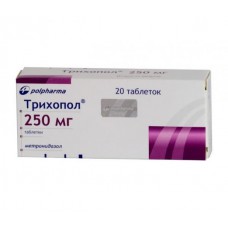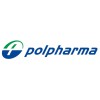Expiration date: 02/2028
The composition and form of issue:
Tablets. 1 tablet contains:
metronidazole 250 mg
auxiliary substances: potato starch — 40, 74 mg of gelatin — 2, 6 mg starch syrup — 6, 6 mg of magnesium stearate — 0, 06 mg
in a contour acheikova packing 10 PCs., in a cardboard pack 2 packs.
Description pharmaceutical form:
Tablets: white to yellowish, round, biconvex, with valium. Turn yellow when exposed to light.
Pharmacological action:
Relates to derivatives of 5-nitroimidazole. Causes a disturbance of the structure of DNA of protozoa and bacteria. Active against Trichomonas vaginalis, Lamblia intestinalis, Entamoeba histolytica, Balantidium coli anaerobic bacteria: gram-negative sticks: Bacteroides spp. (B. fragilis, B. distasonis, B. ovatus, B. thetaiotaomicron, B. vulgatus), Fusobacterium spp., Veillonella spp. gram sticks: Eubacterium spp. Clostridium spp. gram-positive cocci: Peptococcus spp., Peptostreptococcus spp.
Shows activity against Helicobacter pylori.
Pharmacokinetics:
Rapidly absorbed from the gastrointestinal tract (about 80%). After treatment at a dose of 250, 500 mg or 2 g of adult volunteers Cmax in plasma achieved through 1-3 h respectively: 4, 6-6, 5 µg/ml, 11, 5-13 µg/ml and 30 to 45 µg/ml. the Presence of food reduces the rate of absorption and Cmax of the drug in the blood serum. Linking blood protein is low (less than 20%). Penetrates the tissues and body fluids (e.g. bile, saliva, breast milk, vaginal secretions, seminal fluid, cerebrospinal fluid, brain tissue and liver). Metabolized (30-60%) by hydroxylation, oxidation, interaction with glucuronic acid. The main metabolite — 2-oximetronidazol — also has antibacterial and Antiprotozoal activity. Write mainly with urine (60-80%) in feces 6 to 15%. Renal Cl of the drug is 70-100 ml/min in elderly patients the figure below.
Indications:
Trichomoniasis, giardiasis, amebiasis (including amebic liver abscess) infection (abdomen, liver, pelvic organs, skin, bones, lower respiratory tract, CNS, sepsis, endocarditis) caused by anaerobic bacteria mixed (aerobic and anaerobic) infection (in combination with antibiotics) infection of Helicobacter pylori in peptic ulcer disease of the stomach or duodenum (in the complex therapy with the drug bismuth and antibiotics), prevention of infections during surgical operations.
Contraindications:
Hypersensitivity, leukopenia, organic lesions of the Central nervous system, liver failure, pregnancy (I trimester), breast-feeding.
Application of pregnancy and breast-feeding:
Contraindicated in the first trimester of pregnancy in II–III trimester possible, if the expected effect therapy outweighs the potential risk to the fetus. At the time of treatment should stop breastfeeding.
Side effects:
From the nervous system and sensory organs: headache, dizziness, drowsiness/insomnia, peripheral neuropathy, disorientation, nervousness, depression, impaired coordination of movements, seizures (rare).
On the part of the digestive tract: dryness and metallic taste in mouth, anorexia, nausea (most common), discomfort in the region of the gastrointestinal tract, vomiting, constipation/diarrhea (rarely).
With the genitourinary system: pain and discomfort in the region urethral, vaginal dryness and/or of the vulva, decreased libido, painful intercourse, dark color of urine.
Other: leukopenia (rarely, goes away after treatment), thrombocytopenia, rash, pruritus, oral candidiasis, vagina, allergic reactions (urticaria, hyperemia of the nasal mucosa, fever), coated tongue, sore tongue and gums, at/in the introduction of possible thrombophlebitis (reduced when used on/in the catheter).
Drug interactions:
While the use of indirect anticoagulants, metronidazole enhances their effect and increases the prothrombin time increases the effects of lithium salts. Phenytoin and phenobarbital reduce the effect of metronidazole, and cimetidine — increases. Strengthens toxic effect of alcohol. During the simultaneous use of disulfiram and metronidazole can appear acute psychosis and disorientation, so the metronidazole can be assigned in 2 weeks after receiving disulfiram. In a joint application of metronidazole with astemizole and terfenadine arise arrhythmia, ECG changes.
Method of application and dose:
Inside, during or after eating (or drinking milk), without chewing.
Trichomoniasis, men and women — 250 mg 4 times a day (morning and evening) for 5 days or 2 g once or 250 mg 2 times a day (morning and evening) for 10 days.
In amoebiasis: adults: 750 mg 3 times daily for 5-10 days children — 35-50 mg/kg/day in 3 divided doses for 10 days.
Giardiasis: children 2-5 years — the daily dose — 250 mg, 6-10 years — the daily dose — 375 mg, above 10 years and adults — daily dose of 500 mg. the Daily dose should be divided into 2 admission. The course of treatment is 5-10 days, repeated after 4-6 weeks.
Infections caused by anaerobic bacteria: adults and children over 12 years — 250-500 mg 3 times a day, children up to 12 years old, including newborn — 7, 5 mg/kg 3 times a day. The course is not more than 7 days. Metronidazole can be used as monotherapy, or in combination with other antibacterial drugs.
Prevention of infections caused by anaerobic bacteria (before surgical operations on the abdomen, gynecology and obstetrics): adults and children over 12 years: initially, 1 g once, then 250 mg 3 times a day children 5-12 years — 125 mg every 8 hours for 2 days, infants and children up to 5 years — 5 mg/kg every 8 hours for 2 days.
Precautions:
Be used with caution in patients with liver disease (reduce dose), receiving corticosteroids predisposed to the development of edema during treatment necessary to monitor blood picture, to exclude the admission of alcohol.
Trichomoniasis should be simultaneous treatment of sexual partner. The drug can change the results of the analysis for transaminases in serum, LDH, triglycerides and glucose. Patients with adverse symptoms in the Central nervous system should be kept under close medical supervision.
After applying the drug may develop candidiasis of the mouth, vagina or digestive tract. In these cases, the appropriate use of antifungal drugs.
At/in the introduction of the drug may not mix well with other drugs do not use any other drugs administered by infusion.
The solution in polyethylene bottles, which were left after infusion must not be reused. Solution in ampoules can be entered undiluted or diluted with 300-400 ml of physiological solution (prepared before use).


